It seems like it has taken an eternity to get our orchard planted, but thanks to some help from a friend this last weekend, the trees are finally in the ground!
So what took so long? First we had to decide where to put the orchard, then we had to clear the weeds, brush, trash, and copious amounts of poison oak out of the way. Then last year my health, or at that time, lack thereof, set us back an entire year. This last winter though, the deer fence finally went up, trenches were dug, irrigation pipe was glued up, and the orchard space started to take shape.

Clearing a few dead trees, non-native vegetation, and 30 foot poison oak vines, makes a HUGE difference to the slope (click image to enlarge)
All the while, the fruit trees we’d purchased the previous year sat in giant ceramic pots on our front deck, away from the deer, but also not in the orchard where they belonged.
Over the past few weeks, while dodging raindrops, and trying not to create an erosion problem on the slope, we’ve been gradually planting our trees. This however was no simple or straightforward task. You see, the deer, who are now fenced out, are only part of the problem. The gophers and voles can still get in the orchard. As such, for the eighteen trees awaiting a permanent home in the orchard, every single one needed to be fitted with both gopher root guards, and vole trunk guards.
Let’s face it, those prefabricated gopher baskets are expensive, and most are too small to accommodate a sizable bare-root fruit tree. Instead, we bought a giant roll of gopher wire. We dug our holes a minimum of three feet wide by a foot or so deep, adjusting the dimensions as necessary for some of the larger rooted trees, and lined the holes with the wire.
The wire will eventually break down, but by then, we hope at least, that the trees will be large enough to sustain some root damage without permanent injury to the tree. Or maybe by then, we’ll get the gopher population under control…although I doubt they will ever go away.
With the tree tops protected by the deer fence, the roots protected by the gopher-wire, that just left the middle of the trees vulnerable to attack. Voles have been gradually becoming quite a problem here, last year decimating some of our neighbor’s crops. Voles can be deadly to young fruit trees, because they have a nasty habit of stripping the outer bark from the trunks…not unlike an errant string-trimmer, and if enough bark is removed around the circumference of the tree, the tree will die.
We looked for commercial vole guards, but most readily available trunk guards are rather flimsy, or overpriced, and generally not of sufficient quality to assure good long-term protection for the trunk. So instead, we purchased a roll of 1/4″ hardware cloth, broke out the tin-snips, and the hog ringer, and fashioned our own.
Knowing that I’ll never remember the names of all of the trees in the orchard, each tree had a lovely aluminum name tag bestowed upon it, including not just the name of the cultivar, but also the name of the rootstock. If we have any particular disease or hardiness issues down the road, it’s good to know what the rootstock was, in case we need to try a different one.
So each tree was positioned in the hole with the graft union facing northward to protect it from the scorching sun. The roots were decorated with gopher wire, the trunks with hardware cloth, and the branches fitted with stylish aluminum tags…did we forget anything? Oh! Yes.
Lastly, and most importantly, the trees need some food to get them off to a good start. When the holes were dug, the only thing returned to the hole, other than a little bone meal to supply phosphorus for robust root growth, was native soil. I remember when planting almost anything involved amending the dickens out of the soil before you dared to place a plant in the ground. Over the years, that wisdom has shifted as we’ve come to realize that plants are smarter than we give them credit for, and unless you’re trying to plant directly in something akin to concrete, it’s best to let the roots seek most of the nutrients they need, rather than feed it to them on a silver shovel. That said though, top dressing the root zone with a little organic fertilizer, rich in mycorrhizae will help to get the trees off to a solid start, and encourage strong healthy root growth.
To help the trees along during their first season in the ground, this will be a fruitless orchard in 2010. As each tree sets fruit, the newly formed fruits, while still small (preferably less than an inch in diameter) each fruit will be pulled from the tree. As much as we’d love to just let the trees set fruit this year, we’d rather they work on developing a strong, sturdy network of roots. Next year, we’ll see about letting them set fruit.
With the orchard now planted, and blooming, it’s finally time to get to work on the vegetable gardens! Not a moment too soon, as our tomatoes are just about ready to be planted out!



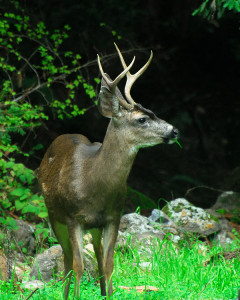
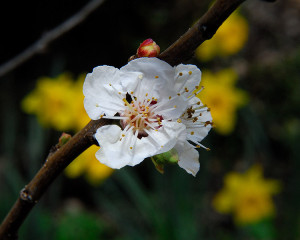
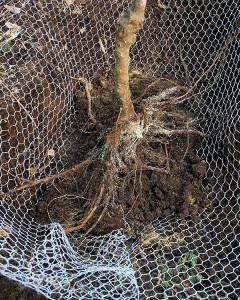
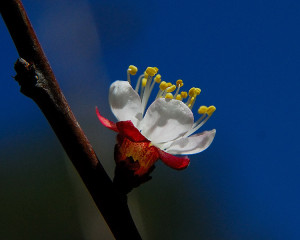
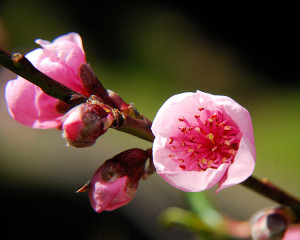
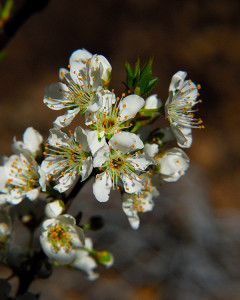
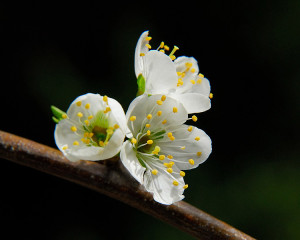
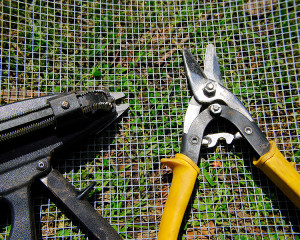
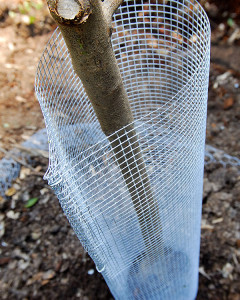
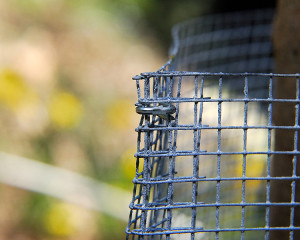
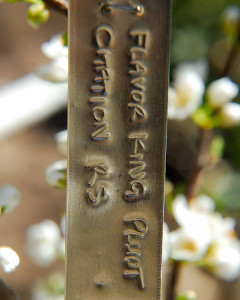
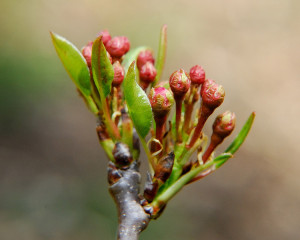
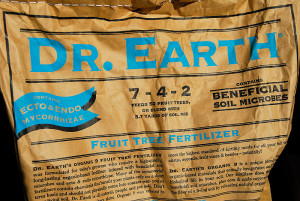
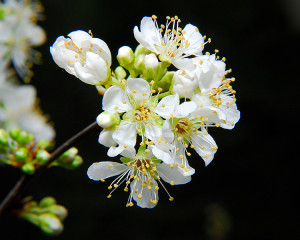
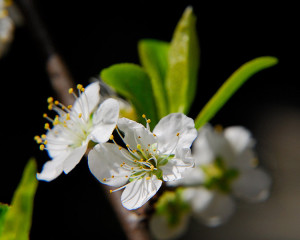







Wow, that’s a lot of work. But kudos to you for making the investment! I really like your photos.
How lovely! I think fruit trees are such a gift. I always dream about winning the lottery and getting all new trees in ore yard. Our house’s previous owners got all ornamental trees which are pretty but I do wish they fed me as well. I will hope for some strong roots for you.
Wow! You have thought of everything and there is probably not another orchard planted so protective and thoughtfully! Good luck with your baby orchard! I would love to see it all planted out. Time to set tomatoes out?! You have such a longer growing season than mine! Still looking out at snow! ;>)
Dear CV, What an amazing account of vision, hard work, more hard work, sweat, toil and now, I really hope, the satisfaction of a properly planted and cared for orchard. What I think is so important about all of this is not only have you planted for yourselves, but for future generations too.
I wish you much happiness with your orchard.
How wonderful… I have yet to plant my fruit trees but am almost there.
Fantastic, CV. You really seem to have thought of everything and done it right. I wish you and your orchard many fruitful years to come!
It sure sounds like a lot of thought has gone into your orchard. Your chances of success are greatly improved by the thorough planning. I know it’s hard to pinch off the fruits the first year but I bet the trees will thank you in the years to come when they grow strong and reward you with lots of fruit!
How wonderful it will be to watch the trees and live off the fat of the land!
Congratulations! That sounds like a lot of work, but I’m sure it will be worth it. Next an owl box, I’d say, to help with the vole problem. BTW, a friend of mine swears by horse manure for fruit trees…
Oh my gosh, what a gargantuan task! The aerial photos alone got an audible gasp out of me! I’m so excited for you and can’t wait to hear about your successful (and hard fought) harvest (next year, that is!)
It’s funny, I was complaining last fall that I didn’t think we were making much progress. That’s when I went skimming through the Google Earth archives. The pic on the left is right after we moved here, and the sunny pic on the right was at the end of last summer. I think I gasped when I saw that too 😛
A lot of the trees had been cut down at least once before we acquired the property, so there was a lot sickly shrubby growth that had come back around the stumps. It really was a mess, but even though our new fruit trees look a bit spindly, it already looks so much better. I can’t wait to get the new native wildflowers established on the slope. We need to keep the bees happy now!
I’m exhausted just reading it, so I can imagine how you feel doing it. A true labour of love.
Hello. You have been so busy. It takes a lot of work to get an orchard started but the rewards will make up for it. I like the deer too but they can be awful when it comes to destroying plants and trees. That buck would love to scrap it rack on one of your new trees. I am glad you have taken precautions against all of the critters.
CV,
So exciting to get a project done like this! I’ve lost my peach tree and have been waiting a good while for our fig to fruit. Good luck with your orchard.
Mmm. I can smell the orchid blooms from here. Lots of work, but well worth it. Cheering you and your orchard on!
Wow, that’s a lot of work, you need a good massage! This is my first visit here, came in via Noelle’s. I appreciate all those works and planning you did, coupled with strong knowledge about caring for the plants. I wish you all the best fruits of your labors. BTW, your photos are excellent. thanks.
Greetings. Sounds like you have a lot of critters to deal with. Notice from the photos that the land has been cleared from a forested area. Curious if air circulation for the orchard will be an issue as well as roots from the hardwoods competing with the new trees. Will the trees have 8 hours of full sun during the day. Fruit trees can be so finicky.
Good luck.
Oh Andrea, a massage sounds really good! The slope was too steep to get the backhoe out there to dig the holes, so we had to hand dig all of them!
Greg, you’re right, it was forested once. Although it was first cleared at the turn of the 20th century when the old-growth redwood forest was logged. We still have some giant old mossy redwood stumps on the property, if those trees were still here, it would be amazing. Then about 25 years ago this particular part of the property was cleared again, when they were first going to put the house on that slope (they changed their mind, but the old foundation is still there). Most of what was on the slope when we arrived was dead, and with the loose soils, we managed to pull a lot of the old roots and stumps out.
As it’s a steep slope, and now quite open, it gets good air circulation, and a lot of sun as it faces predominantly southwest. I think overall, it’s probably better suited to growing fruit than almost anything else…although I admit…harvesting could get a little interesting. We’ll summer prune to keep tree heights in check. For some reason I don’t really want to stand on a 2:1 slope on a pruning ladder to pick fruit! 😛
Congratulations! It must feel wonderful to get this huge job crossed off your to-do list — and it will feel even better in a couple of years when you are harvesting all that wonderful fruit.
Excellent post! Now we know the right way to plant an orchard. As always, you have done a meticulous job, and I am sure your trees will benefit from your careful plans and planting. Now you need to give yourself some of that loving care and protection!
CV, I was shaking my head all the way through that post. There are just so many things you have had to take into acount before so much as thinking of putting one of those trees in the ground. I take my hat off to you, you are an amazing and inspirational gardener!
You’ve done a gigantic job! I’m glad to know that you had some help!
That’s an enormous job you took on … congratulations now that it’s done! Fabulous photos of the tree blooms.
What a labour of love Clare. Such thought and forward planning has gone into this project of yours – I hope you reap the rewards soon with a great harvest once the trees mature alittle more. Its only when you view the aerial photograph you begin to appreciate the size that this project is. I wish you lots and lots of success. Rosie
After seeing how much work you did I’m ready to retire.
Valuable information and great photos. I hope all your precautions will help them withstand attacks and that the trees live long and fruit lots. What kind of fruit trees did you plant?
Good question Melanie, I forgot to link back to our prior ‘Bare Root Fruit’ post where we listed the varietals:
https://curbstonevalley.com/blog/?p=913
They’re also summarized here:
http://www.curbstone.wpengine.com/orchard.htm
We still have room for a few more trees. We may add some more apples and cherries next spring, if all goes well this year!
Wow, you must be exhausted! You sure did lots of work and it is going to be so worth it. Congratulations on finally completing your orchard.
Wow, that is really a personal achievement. All of that work will be there for generations, it is a beautiful thought.
My fruit trees are jealous of all that TLC yours received.